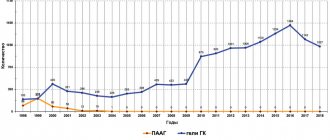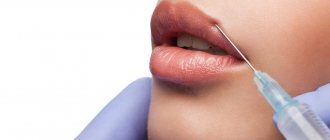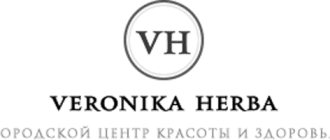Methods for increasing the volume of cheekbones Contraindications Preparation for surgery How malarplasty is performed Rehabilitation Techniques for reducing cheekbones
High, clearly defined cheekbones are one of the brightest signs of beauty, youth and good heredity. In addition, the zygomatic frame keeps the facial tissues taut - nasolabial folds are reduced, the nasolacrimal groove is smoothed, and the corners of the lips are raised. If you didn’t get perfect cheekbones from nature, you can contact a plastic surgeon to correct this area. With the advent of high-quality endoprostheses and the expansion of contouring possibilities, changing the shape of the chin or cheekbones has become not only effective, but also as safe as possible. The operation is performed for congenital or acquired (for example, as a result of an accident) defects of the maxillofacial skeleton and can eliminate the following disadvantages:
- weakly defined cheekbones;
- sagging face oval;
- sunken or too pronounced cheeks;
- deep nasolabial and nasolacrimal folds;
- facial asymmetry.
Possibilities for increasing the volume of the cheekbones
Cheek plastic surgery with implants
Correction of the shape of the cheekbones can be carried out using solid cheekbone prostheses made of porous biocompatible polyethylene or silicone implants. Endoprostheses are installed for life; they do not dissolve or become deformed. During the period of bio-integration, polyethylene implants are filled with the patient’s tissues, the structure is fixed with micro-screws, eliminating the risk of displacement. Silicone implants are more flexible and come in different shapes and sizes. All modern endoprostheses are safe, do not cause allergic reactions or rejection, are installed under the muscle and look as natural as your own cheekbones.
Endoprostheses are selected at the stage of planning the operation. Computer technology helps with this, allowing you to “try on” different types of prostheses. Implants are divided into three groups:
- to increase the width of the face;
- to increase volume and expressiveness;
- combined, solving individual problems, including complex ones.
The shape of cheekbone implants can be oval, elliptical, or anatomical. The latter are more suitable for severe deficiency of the zygomatic bone. Oval ones are most often used to correct the front part of the cheekbones.
Cheek contour contouring
When correcting cheekbones with fillers, preparations based on hyaluronic acid are injected under the skin. Due to this, the volume of the cheeks increases, the skin is moisturized and rejuvenated, and wrinkles are smoothed out. The procedure is carried out by a cosmetologist who carefully studies the contour of the face. The disadvantage of the procedure is the fragility of the result. Hyaluronic filler dissolves over time. Contour plastic surgery needs to be repeated approximately once a year.
Lipofilling of cheekbones
The volume in the right places is replenished with injections of the patient’s pre-treated own fat. The result can last for life, there is no rejection or allergies. Read more about lipofilling of cheeks and cheekbones
Rehabilitation
Features, natural temporary ailments and the duration of the rehabilitation period depend on the technique used.
Do you want your rehabilitation to go smoothly? Then I urge you to be as honest as possible with your surgeon: talk about any ailments if you have them, do not hesitate to ask questions, and conscientiously follow all recommendations.
Anesthesia
Endoprosthetics of cheekbones, removal of Bisha's lumps, check-lifting are performed under general anesthesia. Cheekbone contouring and lipofilling can be performed under general or local anesthesia.
Rehabilitation time
After check-lifting and endoprosthetics, rehabilitation lasts several months. Final recovery is approximately 7-12 months. After removing Bisha's lumps, recovery takes a little less time. After lipofilling and cheekbone contouring, rehabilitation lasts on average 3-4 months.
General rehabilitation recommendations for patients
- You cannot play sports in the first months of rehabilitation.
- Any physical activity should be avoided.
- Don't drink alcohol and give up cigarettes.
- Sleeping on your stomach is not allowed until recovery is complete.
- If the manipulations were carried out through incisions in the oral cavity, I will recommend special rinses.
- Do not steam the skin. Solarium, bathhouse, sauna, hot bath are contraindicated during rehabilitation!
- Do not temporarily apply cosmetics to your face.
- Try not to touch the incision area.
- Do not take medications without my consent.
Contraindications
Surgical correction of the cheekbones should not be resorted to until the formation of bone tissue is completed (up to 25 years), except in cases where surgery is necessary due to a congenital deformity or after an injury. Other contraindications include:
- serious diseases, including chronic ones (oncology, diabetes mellitus, serious damage to internal organs);
- blood clotting disorder;
- period of pregnancy and lactation;
- infections and inflammations (especially in the mouth).
Operation
Correction of the profile of the zygomatic protrusion with implants is performed through internal or external access. In the first case, an incision is made on the mucous membrane from the side of the oral cavity, its length is up to 1 cm. This access is more aesthetic because there are no external scars left. But it carries a greater risk of infectious complications. Before the operation, you will definitely need to visit the dentist and sanitize the oral cavity. With external access or when combined, for example, with a check-lift, an incision is made in the temple area along the hairline or in a natural fold of the skin, so the scar is almost invisible. Its advantage is also that, together with malarplasty, a lift can be done at the same time. After access is established, a “pocket” is made into which the implant is placed on the cheekbone. It is secured with two sutures and surrounding soft tissue.
Wide, low cheekbones don't suit you? This will be corrected by surgery to reduce the cheek bones (reduction malarplasty). 1 day in hospital, 2 months until complete rehabilitation. The result will last a lifetime.
Wide, high cheekbones can be seen on many supermodels - but in real life, those with wide cheekbones are often unhappy with this feature. Why?
The European Cromanoid type with a strong bone structure is characterized by prominent cheekbones, curved at the eye sockets and tapering towards the chin. The upper part of such a zygomatic bone protrudes forward (frontally) from the plane of the face much more than the lower edge. Shaped cheekbones are in demand in the modeling business; they are considered to be a sign of a strong-willed character; in addition, they keep the soft tissues of the cheeks from sagging with age, allowing their owner to maintain the architecture of a youthful face longer.
With the Mongoloid type of face, the cheek bones are also often massive, have a wide and tall body, but lack relief. The zygomatic process of the upper jaw and the zygomatic bone form a single flattened, wide, protruding surface. Protruding wide and flat cheekbones do not create a beautiful, pronounced relief; the face looks massive.
The Renaissance period, when artists and sculptors were interested in mathematics and anatomy, gave us calculations of the ideal proportions of the human body. For the middle third of the face, the ideal width is determined by two ratios:
- the distance between the extreme points of the cheekbones is 4 times greater than the width of the bridge of the nose between the inner corners of the eyes;
- The width of the face between the temples is equal to its width in the region of the mandibular angle and is 10% less than the distance between the edges of the cheekbones.
Previously, owners of large, flat cheekbones could only contour them with a generous layer of decorative cosmetics. Today they offer reduction malarplasty - surgical correction of the width of the face in the cheekbone area. Reducing the cheekbones makes flattened faces more refined, petite and feminine, bringing them closer to classic proportions.
Surgical reduction (reduction) of the cheekbones gives an excellent aesthetic effect on relatively narrow faces, where the area of the cheekbone and zygomatic arch strongly protrudes beyond the boundaries of the ideal oval, while its relief is poorly defined. Since this problem is most typical for the Asian type, South Korea became the pioneer of cheekbone reduction surgery (malarplasty).
Reduction plastic surgery of the cheekbones (Cheek Bone Reduction/Zygoma Reduction) can be performed in three ways:
- cheek bone resurfacing
- osteotomy - excision of a section of the zygomatic bone
- surgical displacement of the zygomatic arch (lateral part of the zygomatic bone and lower part of the temporal bone) inward by dividing into three sections and repositioning
The reduction method is chosen by the surgeon and the patient based on the CT scan data, aesthetic objectives and physiological characteristics of the patient.
Endoscopic malarplasty without repositioning the zygomatic arch is performed under general anesthesia and leaves no marks on the face. It is performed through one incision (in the mouth along the alveolar arch at the level of the incisors) in the case of bone grinding, through three incisions (in the mouth and in the scalp in the area of each temple) in the case of osteosynthesis. The length of the incisions ranges from a few millimeters to 3-5 cm. The risk of damage to the facial nerves during surgery is minimal. In complex cases requiring massive intervention, a combination of malarplasty and endoscopic facelift may be recommended for patients over 30-35 years of age.
The average postoperative hospital stay is 1 day. The active rehabilitation period lasts about 14 days: due to tissue swelling, a compression face mask must be used during this period. As after other operations with intraoral access, after malarplasty there are restrictions on food for some time. Complete facial restoration takes 2-6 months.
In Moscow, malarplasty for aesthetic reasons began relatively recently: unlike South Korean, Singaporean or Chinese surgeons who use standard solutions for pronounced Asian types, Russian specialists work with patients with a mixed type - and for the aesthetic success of the operation an individual approach to each is necessary occasion.
Dr. Guryanov has his own VIP Studio virtual plastic laboratory at his disposal, which allows you to create an individual 3D model based on computed tomography data and three-dimensional light scanning of the face, head and neck. Before malarplasty, the surgeon and the patient plan with high accuracy the desired volume of intervention on a computer model, the system performs calculations, and the result of the operation based on them meets the client’s expectations.
Recovery
The bandage is removed after two days, and the incisions usually take less than a week to heal. To speed up the process, rinses are used (if the dentures were inserted through the mouth).
The patient may experience discomfort for some time (up to 10 days). Painkillers are prescribed to suppress them. Bruising and swelling also form on the face, which usually disappear during the same period.
After 7-10 days, the patient will be able to return to normal life. It may take a little longer for skin sensitivity to recover—up to three months.
For a month, you should refrain from using cosmetics, physical activity, visiting a bathhouse and solarium, swimming in a pool or open water.
Strengthening the muscular-ligamentous apparatus (massage, ultrasound, laser and RF influences)
Loss of facial contour definition usually occurs due to weakening of muscles and ligaments. With age, collagen and elastin fibers, which are responsible for tissue elasticity, lose their quality and stretch. Puffiness is added, which accompanies the deformational type of aging to which most people are susceptible.
To restore clarity to the lines, it is important not only to remove excess fat, but also to carry out measures to strengthen the muscular-ligamentous apparatus and lymphatic drainage.
- Massage techniques
that have a good lymphatic drainage, fat burning and tissue strengthening effect (for example, LPG, Endosphere). - RF devices
(radio frequency exposure) allow tissues to be heated, which causes activation of collagen and elastin, restoring tissue density and elasticity. - The RF needle lifting procedure
additionally creates microtraumas in the skin with small needles, forcing the tissue to regenerate. - Laser devices and focused ultrasound devices
provide deep heating of tissues, triggering the formation of new collagen and reducing adipose tissue.
But if ptosis is too pronounced and there is significant excess skin, it makes no sense to use hardware techniques. In this case, surgical lifting of the lower third of the face and neck is indicated, the results of which will last for a long time.
If you want to get a tightening effect faster and not have to undergo a long course of hardware procedures, you can turn to thread technologies.
Ligature lifting is used to harmonize the lower third of the face, restore the contour of the lower jaw, eliminate a double chin and sagging tissue. The fabrics are stitched with special threads and secured in the desired position, while activating the production of new collagen.
Cheekbone reduction techniques
Correction of the cheekbones may also include reducing volume in this area. Typically, this involves liposuction of the cheeks or proportional augmentation of the lower third of the face in order to balance out the heavier upper part.
Check-lifting
A cheek lift can remove lip sacs, fat above the cheekbones, reduce the depth of nasolabial folds and eliminate wrinkles under the eyes. It can be carried out in superficial and deep ways. For small or medium changes and age-related defects, the skin and a thin layer of subcutaneous fat are corrected using a superficial method. The deep method involves working with the SMAS - muscular aponeurotic system. The result is more pronounced, the technique allows you to correct even pronounced imperfections.
Liposuction of the buccal area
The operation is performed under general anesthesia and lasts from 30 minutes to 1 hour. The fat is sucked out by a vacuum apparatus through thin cannulas with an atraumatic end. Various amounts of fat can be removed at one time - everything is decided based on the patient’s problems and wishes.
Bone remodeling
During the operation, excess volume of the cheekbones is cut off after the soft tissue is peeled away from it. A section of bone may also move inward after osteotomy or reduction.
When is correction indicated?
Age, as well as individual physiological characteristics, influence the shape of the face: the cheeks sink or become covered with a thin layer of fatty tissue, the nasolacrimal groove becomes pronounced, and there may be other changes. Often the shape of the cheekbones is initially poorly expressed or has defects. All of the listed cosmetic imperfections can be corrected by contour plastic surgery.
The procedure is indicated not only for those who have been affected by age-related changes, but also for those who want aristocratic facial features, turning flaws into advantages.









